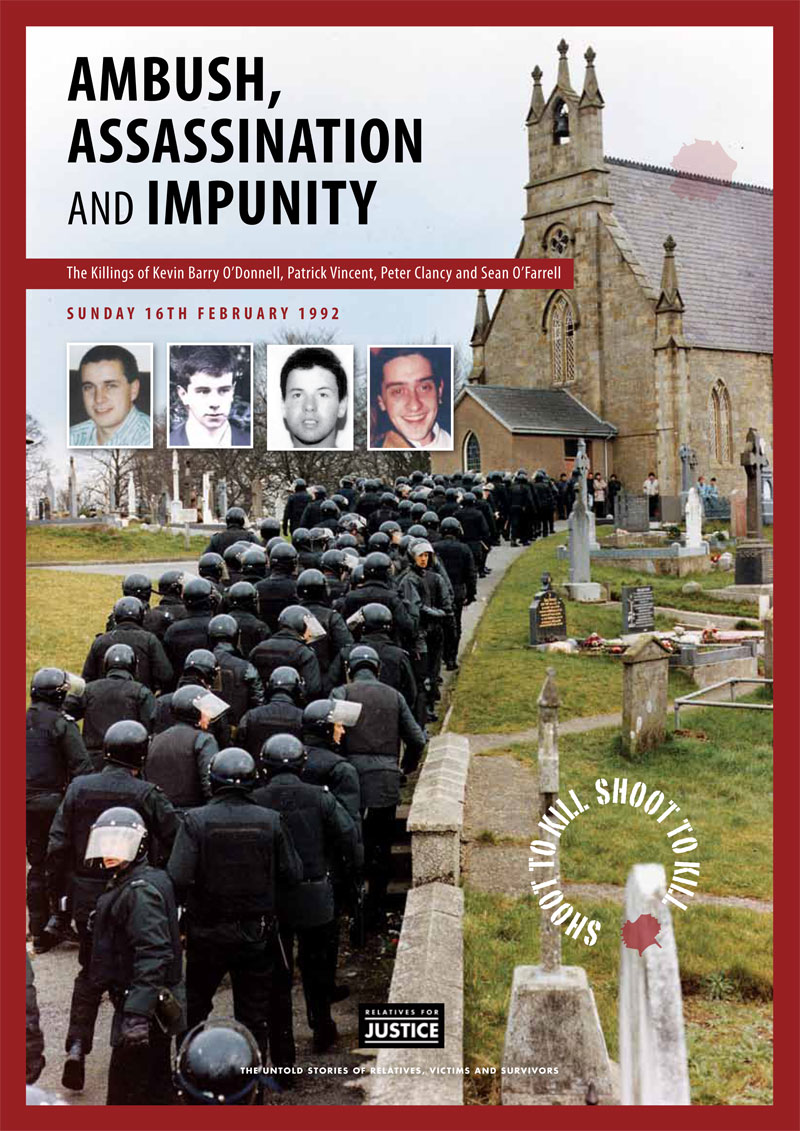After decades of impunity, former military personnel of a Special Military Unit (SMU) of the British Army who fired live rounds in the ambush at Clonoe Chapel, killing Kevin Barry O’Donnell, Patrick Vincent, Sean O’Farrell and Peter Clancy in 1992, have started giving evidence this week.
This last part of the Clonoe inquest has commenced with the long-awaited evidence of former SAS soldiers who carried out the military operation in which the four IRA men were killed. Their relatives have waited three decades for this inquest when those responsible for the killings would answer the pertinent questions about their actions and those who sanctioned them. This legitimate expectation has met the strategy adopted by former soldiers appearing in court remotely and, following legal advice, refusing to answer questions relating to the fatal incident.
Under Rule 9 of the Coroners (Practice and Procedure) Rules (Northern Ireland) 1963, witnesses at inquests are not obliged to answer questions that might incriminate them.
Coroner Mr Justice Humphreys has heard the evidence recorded on very brief and limited statements taken in the last week from former military witnesses known to this inquest as Soldier K, Soldier C and Soldier I. The three statements are almost identical. These state that they were members of the SMU based in England, the type of training they received and that they were temporarily deployed to the North of Ireland in February 1992 for the specific operation in which O’Donnell, Vincent, Clancy and O’Farrell were killed. According to their statements, they were briefed about the operation, which was to be an “arrest operation”, albeit no indication exists of any attempt to apprehend the young men despite the several opportunities the authorities had. On the contrary, there is evidence that indicates the British soldiers opened fire against the lorry in which the young men were travelling before the vehicle even stopped, with no warnings given.
Soldiers K, C, and I’s testimonies seemed to have forgotten who briefed them at the time. This is interesting because their 1992 statements say that it was Soldier A who gave the briefing, indicating he was in charge of the operation on the ground. Conveniently, the three former soldiers refused to adopt those statements into their evidence, saying they have no recollection of giving them.
The original statement attributed to Soldier K, which, like the others, was taken by DCI Molloy in 1992, places him behind the hedgerow from where the British Army opened fire towards the car park of Clonoe Chapel. He refused to answer any questions relating to the shooting and its immediate aftermath, including whether he opened fire, as well as to the questions of his perception of any threats and any potential justification for the use and necessity of lethal force. The other two military witnesses adopted the same strategy.
The 1992 statement attributed to Soldier C describes how he shot Patrick Vincent, who was in the cabin of the lorry, and the ballistics report and evidence based on the cartridges recovered from the scene are consistent with the approximate movements of Soldier C from behind the hedgerow to the cabin of the lorry too. However, the military witness adopted the same strategy as Soldier K and refused to answer questions by invoking the privilege against self-incrimination. This proved frustrating and emotionally challenging for the Vincent family.
The statement attributed to Soldier I places him along the hedgerow with the rest of the SAS soldiers who fired shots. According to the document, he then moved towards and fired at a man who had been sitting in a vehicle in the car park of the chapel. This man, Aidan McKeever, was injured as a consequence, and later arrested and convicted.
Mr McKeever was one of the civilian witnesses who gave evidence in the inquest this week. He explained that as he lay injured on the ground when British soldiers apprehended him, he told them he was in the car park of the chapel to visit his father’s grave. The witness claimed that he lied because he believed that he would be killed if the British soldiers found out he had anything to do with the other men. Mr McKeever filed a claim against the Ministry of Defence in 1995 seeking damages for the injuries he sustained in the ambush. His evidence from the civil case was adopted as part of the evidence to this inquest. Following the claim, the High Court in Belfast found the soldiers’ actions on the evening of the 16th of February 1992 were “unjustified”.
The inquest continues next week with further evidence from former SAS soldiers. It is, however, expected that all of them will adopt the same strategy of invoking the privilege against self-incrimination.
The RFJ Report on the killings in Clonoe can be read here











